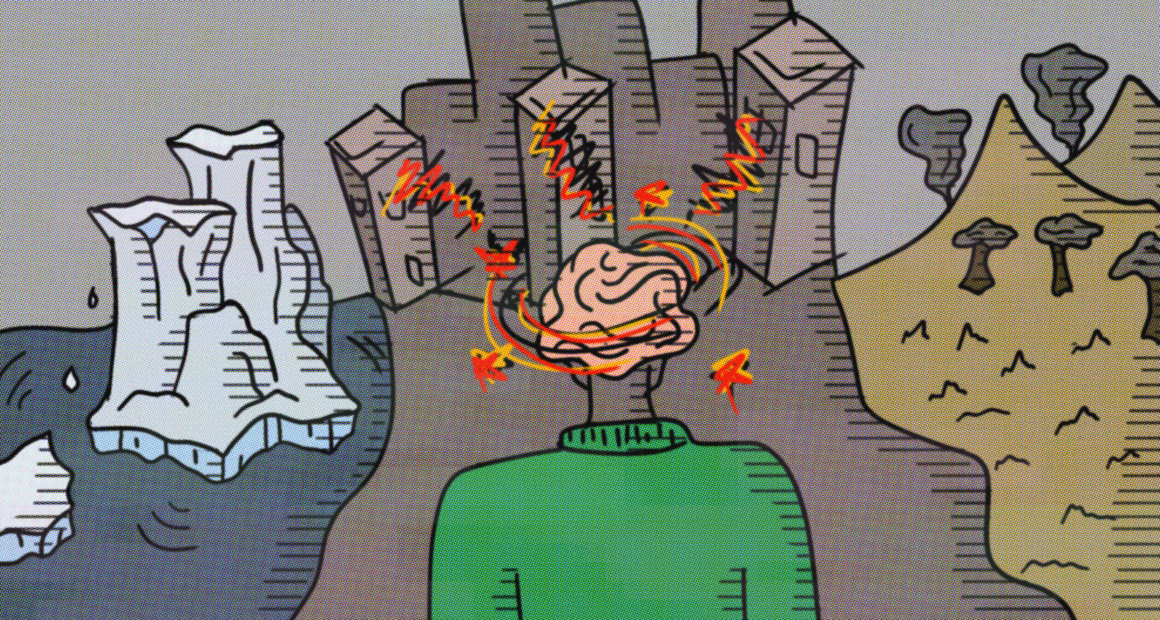Lack of mental health discussion and expertise means newsrooms are home to stressed-out, burned-out and overworked staff

It’s 2010 and Mike Drolet, a correspondent for Global National is one of the first Canadian journalists to cover the devastating earthquake that struck Haiti and killed 222,570 people. First arriving in the Dominican Republic, he leaves behind all of his belongings except for the camera and editing gear. He hops on an NGO-rented helicopter to fly into Haiti.
“It was hell. It was exciting when we found a piece of cardboard to sleep on under the stars for the week. I didn’t even have clothes to change into for 5 days,” says Drolet. He has more than two decades’ of experience covering natural disasters, school shootings, the war in Afghanistan, and the funeral of the officer killed in the 2014 attack on Parliament. Yet 13 years after reporting on the aftermath of the earthquake in Haiti, he can still tell you exactly what death smells like. It stays with him to this day.
Drolet recalls interviewing a man who told him he was standing on top of his family, who were buried under the rubble. It was an emotional moment for Drolet, and he decided the best thing he could do was “honour that person by telling their story and doing good journalism.”
A similar pattern is now occuring after the earthquake that devastated Turkey and Syria in early February, resulting in more than 50,000 deaths. As news continues to develop on this tragedy, newsrooms compete for headlines with limited resources, and little regard for how to prepare journalists for the effects it may have on their mental health.
Good journalism happens when a journalist understands the risks of their work, has been trained well for it, and is confident in the support of their employers during and after covering stories involving trauma, say Matthew Pearson and Dave Seglins, co-authors of Taking Care, a report that surveyed over a thousand Canadian journalists about their mental health.
The analysis found an alarming amount of stress reported by respondents. The research also demonstrated that media workers are at higher risk of anxiety and depression than the average Canadian due to their direct exposure to traumatic events. According to the report, although employers seem to care about journalists’ psychological well-being, there’s simply not enough being done to protect their mental health.
While empathy for sources is important, because their stories matter, Drolet explains, “If you get so involved or emotionally attached then it makes it more difficult to do your job. You’re trying to tell their story to be able to tell the world…if you become completely overwhelmed, you’re not going to be able to do it.”
Drolet says he was never trained for the mental health implications of the job. He says conversations in the newsroom for him usually go like this:
“Do you want to go?”
“Sure.”
Reporters risk compassion fatigue, burnout and traumatic stress in their work, according to the Taking Care report.
Jane Hawkes, cofounder of the Canadian Journalism Forum on Violence and Trauma, says there is a big shift happening when it comes to defining “frontlines,” especially for climate journalists, many of whom carry the weight of climate anxiety—stress related to the effects of climate change, as seen in much natural disaster coverage.
It’s an appropriate response to the crisis that may cause grief, anger and shame, all of which can affect one’s mood and thinking, says climate psychologist Megan Kennedy-Woodard.
“Always remember, you’re interacting with people who are probably having the worst time of their lives, whatever larger impact the news event is having on the environment. You come home, but that doesn’t mean the trauma of what you’ve experienced isn’t still with you,” says Hawkes.
According to the Dart Center for Journalism and Trauma, journalists are among the last groups to recognize the psychological effects of their work.
The Taking Care report indicated that 51 percent of media workers said it was hard to take a break. Over two-thirds have never refused an assignment that made them uncomfortable, even though almost half wanted to.
“It’s about a culture shift to say, oh mental health is a thing, we need to acknowledge it within our workplace and stop pretending journalism doesn’t affect people,” says Dave Seglins, an investigative journalist with CBC, who is known as the broadcaster’s mental health and well-being champion.
Matthew Pearson, an assistant professor at Carleton University, is working to integrate trauma-informed reporting, as well as self-care for journalists, into the school’s curriculum. He says it would have been beneficial for him as a once ambitious student to hear that “some stories are going to impact you, and that’s okay because the world is messy and complex.”
He encourages students to think of restorative self-care as a non-negotiable psychological, spiritual or physical habit. In doing so, he tries not to replicate the current newsroom environment.
Hawkes adds that while progress has been made, “we need to build mental health literacy if we’re going to speak more effectively about it in a newsroom. Taking that care really helps to lessen stigma. When you build informed discussions into the newsroom culture, colleagues are less likely to feel singled out.”
Although some big newsrooms attempt to offer psychological counselling support after an employee is exposed to something traumatic, there is more to be done to support a journalist’s well-being before and during their assignment, according to Seglins.
He imagines a psychologically safe work environment that “addresses and acknowledges the story can be emotionally heavy,” thus giving people a choice to cover a story or not based on how their lived experience will affect their mental health.
Seglins covered stories about death, destruction and suffering that caused him to develop anxiety and post-traumatic stress disorder. As a senior journalist, he stood up for himself by declining a story, but was told he couldn’t. That’s when Seglins was inspired to defend mental health and well-being in the newsroom.
“Actually I can, and I should. It’s actually a very healthy thing and a smart thing to do. And this is exactly how this should work,” he remembers saying.
When Drolet first went overseas for a story, his eyes were “wide open.” Now, after many experiences, he emphasizes that journalists who find themselves in a dangerous environment should know the challenges and what to expect beforehand. Although this is often only learned in the field, he notes that journalists who want to report in these environments need to self-reflect on how they can manage their emotional state.
As the effects of climate change continue to increase, and as journalists inevitably rush to report on these disasters, newsrooms must answer the call to apply new strategies that shift the culture of Canadian media to support its journalists in serving the public.
About the author
Megan Camlasaran is a fourth-year undergraduate journalism student at Toronto Metropolitan University. She has worked as a freelance reporter for The Bridge News, a local Toronto newspaper, was a writer for a start-up magazine Posséder and is currently an intern with Lead Podcasting. She is passionate about building community understanding through written and audio works that centre on diversity and mental health issues. You can also always find her outside on a sunny day, probably hiking, reading or searching for a new plant to bring home.





